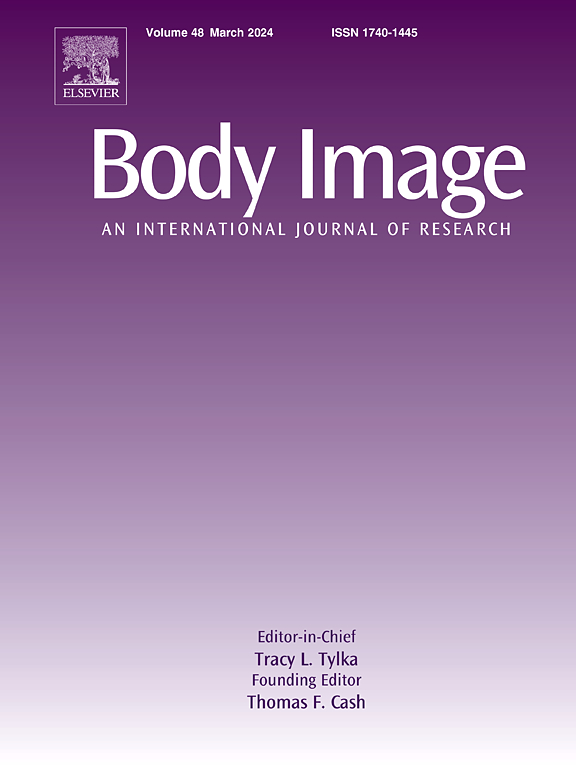看到两面:使用以人为本的方法检查意大利青少年消极和积极身体形象的概况
IF 5.4
1区 心理学
Q1 PSYCHIATRY
引用次数: 0
摘要
负面的身体形象在青春期非常普遍,并与各种有害后果有关。相反,积极的身体形象被认为是一种独特的结构,可以促进心理健康。尽管他们的反向关联,消极和积极的身体形象理论上存在于不同的连续体,并可能共存于个人。然而,这种共存是否能在青少年中被实证地识别仍不清楚。为了解决这一问题,本研究采用潜在轮廓分析(LPA)来确定1023名14-19岁的意大利青少年的负面身体形象(即身体不满和身体羞耻)和积极身体形象(即身体和功能欣赏)的轮廓。此外,还研究了这些特征与饮食失调(ED)症状、理想美内化和外表比较之间的关系。LPA揭示了男孩和女孩的三种不同的特征:“强烈的消极身体形象和弱的积极身体形象”,“弱的消极身体形象和强的积极身体形象”,以及“中度的消极和积极身体形象”。“弱负面身体形象和强正面身体形象”组的青少年在ED症状、瘦理想内化和外表比较频率方面的得分明显较低。这些发现支持消极和积极的身体形象共存,并表明积极的身体形象可能在青少年时期对适应不良的结果起保护作用。这可能对针对青少年人口的预防性干预措施的实施产生重要影响。本文章由计算机程序翻译,如有差异,请以英文原文为准。
Seeing both sides: Examining profiles of negative and positive body image among Italian adolescents using a person-centered approach
Negative body image is highly prevalent during adolescence and is associated with a wide range of harmful consequences. In contrast, positive body image is recognized as a distinct construct that may promote psychological well-being. Despite their inverse association, negative and positive body image are theorized to exist on separate continua and may coexist within individuals. However, whether this coexistence can be empirically identified among adolescents remains unclear. To address this, the present study employed Latent Profile Analysis (LPA) to pinpoint profiles of negative body image (i.e., body dissatisfaction and body shame) and positive body image (i.e., body and functionality appreciation) in a sample of 1023 Italian adolescents aged 14–19 years. Additionally, associations between these profiles and eating disorder (ED) symptoms, beauty-ideal internalization, and appearance comparisons were examined. The LPA revealed three distinct profiles for both boys and girls: “Strong negative body image and weak positive body image”, “Weak negative body image and strong positive body image”, and “Moderate negative and positive body image”. Adolescents in the “Weak negative body image and strong positive body image” profile scored significantly lower in terms of ED symptoms, thin-ideal internalization, and frequency of appearance comparisons. These findings support the coexistence of negative and positive body image and suggest that positive body image may play a protective role against maladaptive outcomes during adolescence. This can have important implications for the implementation of preventive interventions aimed at the adolescent population.
求助全文
通过发布文献求助,成功后即可免费获取论文全文。
去求助
来源期刊

Body Image
Multiple-
CiteScore
8.70
自引率
28.80%
发文量
174
期刊介绍:
Body Image is an international, peer-reviewed journal that publishes high-quality, scientific articles on body image and human physical appearance. Body Image is a multi-faceted concept that refers to persons perceptions and attitudes about their own body, particularly but not exclusively its appearance. The journal invites contributions from a broad range of disciplines-psychological science, other social and behavioral sciences, and medical and health sciences. The journal publishes original research articles, brief research reports, theoretical and review papers, and science-based practitioner reports of interest. Dissertation abstracts are also published online, and the journal gives an annual award for the best doctoral dissertation in this field.
 求助内容:
求助内容: 应助结果提醒方式:
应助结果提醒方式:


